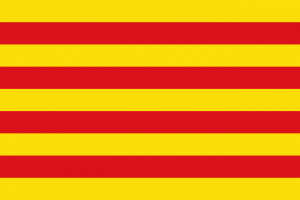Language/Catalan/Vocabulary/Telling-Time
| ◀️ Numbers 1-100 — Previous Lesson | Next Lesson — Adjective Agreement ▶️ |
Introduction
In this lesson, you will learn how to tell time in Catalan. Time is a crucial part of everyday life and communication, hence it is essential to know how to tell time in a new language. If you are planning to travel or live in a Catalan-speaking region, it is necessary to learn how to tell time as it can be very helpful when navigating your surroundings. By the end of this lesson, you will know how to tell time in Catalan, including hours, minutes, and phrases for discussing past, present, and future events.
With the completion of this lesson, consider investigating these related pages: Weather and Climate & Meat.
Telling Time in Catalan
The following table shows the numbers from one to twelve and how they are pronounced in Catalan:
| Catalan | Pronunciation | English |
|---|---|---|
| u | oo | one |
| dos | dohs | two |
| tres | trehs | three |
| quatre | kah-treh | four |
| cinc | seenk | five |
| sis | sees | six |
| set | set | seven |
| vuit | bwit | eight |
| nou | noh | nine |
| deu | deh-ooh | ten |
| onze | ohn-zyeh | eleven |
| dotze | doh-tseh | twelve |
Telling the Hours
Telling time in Catalan is relatively straightforward. To express an hour, you use the word "hora" followed by the hour number. You can use the word "davant" before the hour number to specify that it is before the hour, or the word "passades" to specify that it is past the hour.
Here are some examples:
- Són les tres - It's 3 o'clock
- Són les set passades - It's past 7 o'clock
- Són les deu davant - It's before 10 o'clock
Telling the Minutes
To tell the time in minutes, you add the corresponding minutes after the hour number. The word for minutes in Catalan is "minuts."
Here are some examples:
- Són les tres i vint - It's 3:20
- Són les set i mitja - It's half past 7 (literally, "half eleven")
- Són les dotze menys quatre - It's four minutes to twelve
Telling the Time of Day
To express the time of day in Catalan, you can use the following phrases:
- Del matí - In the morning (from sunrise until approximately noon)
- De la tarda - In the afternoon (from noon until sunset)
- De la nit - At night (from sunset until sunrise)
Here are some examples:
- Són les dues del matí - It's 2 a.m.
- Són les cinc de la tarda - It's 5 p.m.
- Són les onze de la nit - It's 11 p.m.
Discussing Past, Present, and Future Events
To discuss past, present, and future events in Catalan, you can use the following phrases:
- Passat - Past
- Present - Present
- Futur - Future
Here are some examples:
- Vaig arribar a les dues passades - I arrived at half past two (past event)
- Estic arribant ara mateix - I'm arriving right now (present event)
- Arribaré a les cinc - I will arrive at 5 o'clock (future event)
Practice
Now that you have learned how to tell time in Catalan, let's practice!
- ¿A quina hora arribes a la feina normalment? - At what time do you usually arrive at work?
- Jo sempre surto de casa a les set del matí. - I always leave the house at 7 a.m.
- La pel·lícula comença a les nou de la nit. - The movie starts at 9 p.m.
- ¿Vols anar a sopar a les vuit del vespre? - Do you want to go to dinner at 8 p.m.?
- Avui em llevaré a les sis del matí per anar a córrer. - Today I will wake up at 6 a.m. to go for a run.
Conclusion
In this lesson, you learned how to tell time in Catalan. You now know how to express the time of day, the minutes, and past, present, and future events. Practice speaking and writing in Catalan to perfect your skills. In the next lesson, we will focus on Adjectives and Pronouns.
Well done on mastering this lesson! Don't miss these related pages to expand your knowledge: Nature & Stores and Public Buildings.
Other Lessons
- Languages
- Prepositions in Catalan
- Literary and academic vocabulary
- Computer
- Greetings
- City
- Food
- At the Restaurant
- Useful Expression in Catalan
- Family Members
Sources
- Catalan Tutorial: Basic Catalan Phrases, Vocabulary, and Grammar
- Catalan - Definition, Meaning & Synonyms | Vocabulary.com
- Is Catalan hard or easy to learn? (It depends.) - Relearn A Language
| ◀️ Numbers 1-100 — Previous Lesson | Next Lesson — Adjective Agreement ▶️ |

